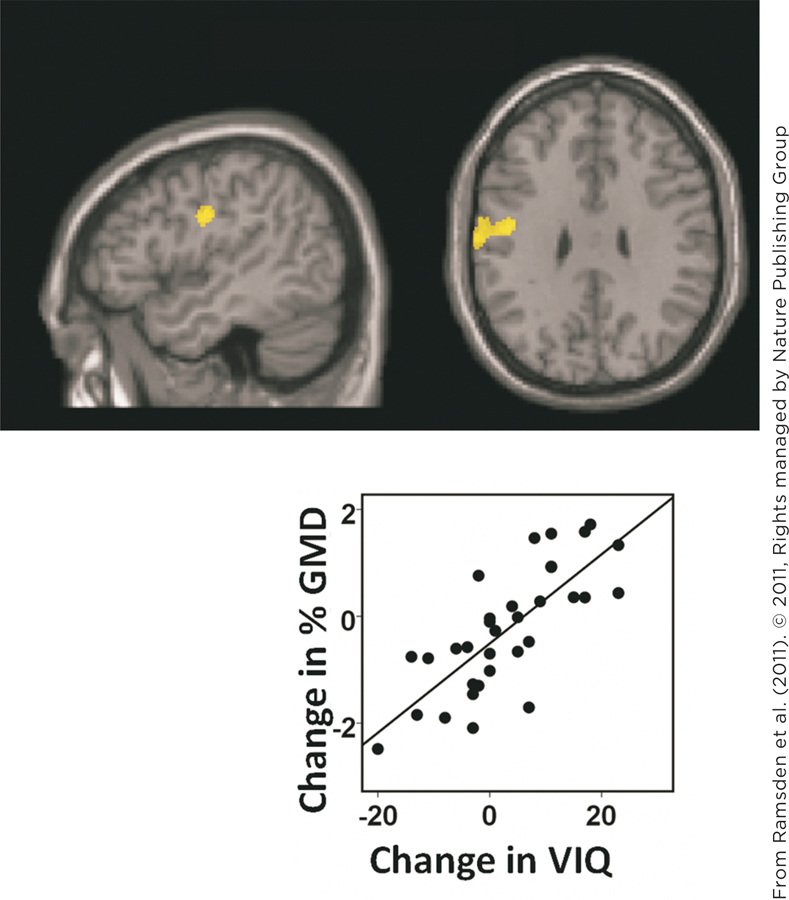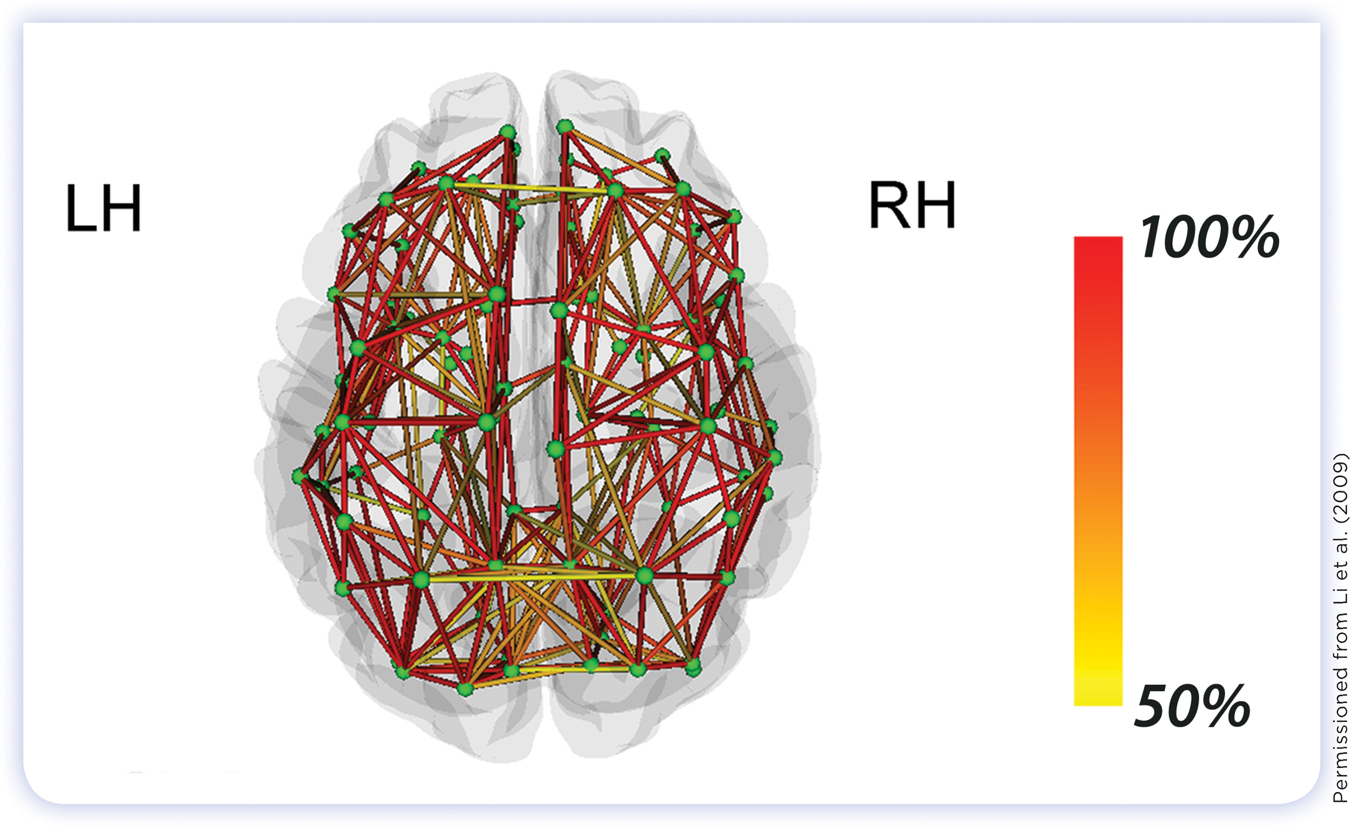8.7 Intelligence
You probably have a good sense of your level of intelligence. Most people have taken standardized intelligence tests and received scores ranking them in comparison to others. However, you may have less understanding of what, exactly, intelligence is. Is it something in your head—
If you’ve ever asked yourself what intelligence is, you’re not alone. Psychologists puzzle over the question. Although researchers have developed measures of intelligence and identified factors that influence people’s intelligence test scores, basic questions about the nature of intelligence are debated to the present day. Let’s begin our study of intelligence, then, by examining definitions of the term.
342
Defining Intelligence
Preview Question
Question
 What is—
What is—
We call people “intelligent” when we see them do something difficult that requires thinking. Whether it’s learning a foreign language, solving a math problem, inventing the electric light bulb, developing a novel form of poetry, or just correctly answering lots of questions on an intelligence test, the accomplishment—
This definition indicates not only what intelligence is, but also what it is not. “Intelligence” does not refer to the following:
Personality traits: Personality traits are motivational and emotional tendencies (see Chapter 13), not mental abilities.
Physical abilities: You might be able to run a marathon or lift 200 pounds over your head, but these abilities, which require little knowledge, are not signs of intelligence.
Specific skills: A person who, for example, has exceptional memory for baseball statistics or an unusually good sense of direction, but who does not display a broad ability to comprehend information, would not be said to be highly intelligent.
WHAT DO YOU KNOW?…
Question 24
Check the items below that most psychologists would agree are indicators of intelligence.
- U5QwXbN3jVfKWwDuKW/fm4qE0tpmc7GkAMsyY2dQPcmwtQk2KKM99ChtORsLh9T4VIbI/I+2gWuGK8XytKkPq5N+l9aB45BTARu4mFz6MmGatzIKMjxiq3L4aM0uB4Pc
- cI1xHNEUwRr2aJA6XtJ8uq6GEOL3YcAnKf7ETJLy+bH3hw0TawScuj1xMHDQ5Id8lcD+YGvhv3w8WpNHN4BjuynkzkItArf5
- JoyXkOXHSlRN6+7BNFiFbS1liAJyLAHftd6r82OMmXEBW4jZDHDIrdHWui5X1utCQRqNAQhP88lxveOKdXnVgg==
- pAaPVIknBUaSqzlNu9GAgk/L6G6gOmJAkkHkF/ySsG/T9pLKDMRPQhRx1OeddgsyqT/Hc2WybOcsfINn9peEJw==
- 0JzmZ/WQaQ99sArCCLlqmaGixCGT9mjcP+mmGqTOqWrzK+1ia2AdJuyoHMZ8wO0qhTAHt2KfgXOmVpFRGkwzJq9q+d684shkmItfrA==
“General” Intelligence and Differences Between People
Preview Question
Question
 How has intelligence been measured?
How has intelligence been measured?
Question
 Is there a “general” intelligence?
Is there a “general” intelligence?
Question
 What cognitive processes contribute to individual differences in general intelligence?
What cognitive processes contribute to individual differences in general intelligence?
Our definition of intelligence leaves some important questions unanswered. The most significant is whether there is one type of intelligence or multiple types, that is, distinct mental abilities, each of which is a type of intelligence. Let’s look at the origins of intelligence testing, which focused on measuring one type of intelligence, known as general intelligence.
343
ORIGINS OF INTELLIGENCE TESTING AND IQ. More than a century ago, psychologists began to measure differences in people’s mental abilities (Brody, 1992; Fancher, 1979). A pioneer in the field was the French psychologist Alfred Binet. Binet reasoned that some children might have mental disabilities and thus would need extra help from teachers. To identify these children, Binet devised an intelligence test.
Before Binet, psychologists interested in intelligence had measured people’s perceptual ability and memory capacity. Binet’s test, however, was different. He measured logical reasoning, vocabulary use, and factual knowledge; children taking his test had to identify objects, explain the logical relation between ideas, and construct sentences using challenging vocabulary words. These test items tapped abilities that are important to school achievement. Binet’s test thus was a success; test scores predicted classroom achievement. Today’s intelligence tests, which employ items similar to those Binet developed, strongly predict school success (Greven et al., 2009).
How well do you think scores on intelligence tests predict success outside of school, such as at work or in social situations?
In 1912 a German psychologist, William Stern, provided a valuable scoring system for intelligence tests (Wasserman & Tulsky, 2005). Stern capitalized on an insight from Binet, who recognized that, when assessing a child’s intelligence, one should consider the child’s age. Different children might develop the same ability at different ages. The child who develops the ability earlier is said to be more intelligent.


Stern included age in a formula for computing intelligence quotient, or IQ, which is a measure of overall intelligence that takes into account a person’s age. It does so by relating any given child’s test performance to the average age of children who perform similarly on that test. Here’s an example.
344
Suppose that a 7-
year- old child takes an intelligence test with 60 items and answers 43 correctly. Suppose also that many other children of different ages have previously taken the test, and the average age at which they first were able to answer 43 questions was age 8.
The mental age of the 7-
Stern included mental age in his formula for IQ:
IQ = (mental age/chronological age) × 100
An average child—
THE NATURE OF GENERAL INTELLIGENCE. Computing a person’s IQ score is easy. But it leaves a difficult question unanswered: “What, exactly, does the IQ score measure?”
The first step in answering that question involves the following fact: Whenever people take tests measuring different mental abilities, those who get high scores on any one test (e.g., verbal skills) tend also to get high scores on others (e.g., math skills). Individual differences on the separate tests correlate positively (Deary, 2001). What explains the positive correlations? More than a century ago, the British psychologist Charles Spearman (1904) explained them by proposing the variable general intelligence, or g. People with high (low) g tend to perform well (poorly) on tests of mental ability.
IQ, then, measures g. IQ scores measure individual differences in general intelligence.
THINK ABOUT IT
Is general intelligence something that psychologists discovered? Or is it an idea that psychologists invented?
Let’s see exactly how this works by examining one popular test of intelligence, the Wechsler Adult Intelligence Scale, or the WAIS (Wechsler, 2008). The WAIS includes measures of four aspects of mental ability:
Verbal Comprehension: The ability to comprehend words, verbally presented information, and the relations among pieces of verbal information
Perceptual Reasoning: The ability to remember, reason about, and solve problems involving pictures, shapes, and other visually presented material
Working Memory: The ability to retain and manipulate information in working memory
Processing Speed: The ability to respond rapidly to simple information, such as reading a letter on a page and writing it down as quickly as possible

345
Although these four abilities are distinct—

Is g a single thing—
It might at first sound odd that the single variable g does not correspond to a single thing in the brain. An analogy makes it clear. Suppose you’re running a theatre group, putting on a musical, and need people for the show. You develop tests for the needed talents: a singing test, a dancing test, a test for stage design ability, and a test for technical skills such as lighting the stage. People’s scores on these tests might correlate positively. Even if they do, that doesn’t mean people’s brains contain a “General Theatre Ability.” There are other explanations for the positive correlations. People who sing well in childhood might be more likely to appear in stage shows. Once in the shows, they receive dance lessons. Eventually, they hang out with people who do stage design and lighting. As a result of these experiences, they pick up diverse theatre-
These skills are significant. People with higher scores on tests of general intelligence often achieve higher levels of academic and professional success. A study of tens of thousands of British schoolchildren showed that general intelligence scores at age 11 substantially predicted school achievement in math and English at age 16 (Deary et al., 2007). Research relating g to professional success indicates that higher levels of general intelligence predict higher levels of success in job-
GENERAL INTELLIGENCE AND WORKING MEMORY. The psychologist Raymond Cattell (1987) explained that, to identify cognitive processes that contribute to intelligence, you first have to distinguish between two forms of general intelligence: fluid and crystallized. Fluid intelligence refers to mental abilities that can benefit performance on almost any challenging task; these abilities have “the ‘fluid’ quality of being directable to almost any problem” (Cattell, 1987, p. 97). Thanks to fluid abilities, people can perform intelligently even on tasks they have never seen before (e.g., puzzles, logic problems, or detecting patterns in a series of geometric shapes). Crystallized intelligence refers to socially acquired knowledge. Someone who knows a lot of facts, or an unusually large number of vocabulary words, would be said to have high crystallized intelligence. In contrast to fluid intelligence, the knowledge that comprises crystallized intelligence is generally more helpful on some tasks than others; knowing words, for example, helps in solving verbal problems but not arithmetic problems.
346

It is difficult to identify specific cognitive processes that contribute to crystallized intelligence. This aspect of knowledge is diverse—
Working memory (see Chapter 7) holds information for brief periods and functions as an “executive” that focuses a person’s attention on tasks and helps people to avoid distraction. Individual differences in working memory capacity predict individual difference in fluid intelligence (Engle, 2002). For instance, when researchers measure people’s ability to avoid distraction, those who are less distractible are found to have higher fluid intelligence (Engle et al., 1999) and higher scores on intelligence tests that combine fluid and crystallized intelligence abilities (Colom et al., 2004).
Have you ever tried to train yourself to avoid distraction?
Individual differences in working memory capacity thus contribute to individual differences in fluid intelligence. This fact, however, leaves unanswered the following question: Why do people differ in working memory capacity and fluid intelligence? In other words, why are some people smarter than others?
WHAT DO YOU KNOW?…
Question 25
YaWBYGhrglwljQOuinzpyPz3lZPO87++b1KOtoWfbKZWgQKCPElDu12FSEhvVNic8ciK+8J+5os4nRXWBWx0IiZKrA6Nnp85/Ij4lkCoct97QUqI9xfY8ZmCyPPg0PP2pgDHeNwfPAsYFkF+3ZdGLY+FPHdESlbAK91OcI6V1pGqf06DvCEBPFuEkwCUowsrGVcXYr+GJHFj9HSfrWFQw1Q6rByn+MpvNhdXs9TGpUV0CI9CeiojVoQpn2aldQDqyPDjxBpTC+wVgO0fj508W4kBBTNAX+L4fugi5bTcZ/gk/Ix4kUNX+x7i1x24QNvyjdzV/g==Question 26
3033Yaxl1TYMf7Ous6fn5pm8nvJ5FLG4os+wxxbItrnT5JnJvd3CuAtrqiR2dHwkivPj6Vvjye3Ep+qmLPXZUWRok1jqdP5sNRrtDRYOa2mj7W1ZqN6DacrkHFtUUnt/ZpnNATHE2OQb4HVn231iyQL58uoINCEVkDUWFYbxqiVRq1FzwbmoTcSGozUBihnFNv5jZjKkdsXbaqk2KWg9Jh8RnyA4AmgCA0PvZNelJRAzOzEfTQsvcg==Question 27
PBqOUA==Question 28
djBuV5zT+fcx7q5o5Uel+cjdW580y55AcYIAXuK3j+gy24XmAbk8Or6NlZD3pc80tSqp9/E4i+YqWF8HlADNnzFSBPZIgFK9i3JZrzMfrTlfLtbC8HuF910QkuU3VmxetkLSUnRWRWGr30xnaDceRV6m3DCpSWA2i9vxg2qWSwmnBSdBLe0VNw==Inherited Biology and Intelligence
Preview Question
Question
 Is inherited biology the only determinant of intelligence?
Is inherited biology the only determinant of intelligence?
One possible cause of individual differences in intelligence is biological inheritance. Just as people inherit genes that determine their eye color or height (see Chapter 4), they may inherit genes that determine their level of intelligence. Intelligence, then, may be a fixed, genetically determined quality that you couldn’t alter even if you wanted to.
347
Over the years, some psychologists have made this claim. If intelligence is biologically determined, then society perhaps should not spend much money educating people with low IQ scores, because education won’t boost their intellectual ability (Herrnstein & Murray, 1994; Jensen, 1969).
Do the facts support the controversial claim that intelligence is determined genetically? Let’s look closely at this question by examining a biologically determined trait and then comparing it to intelligence.
Here are four facts about height, a biologically determined trait:
There are few if any differences in the average level of the trait from one generation of humans to the next. The genetic material possessed by any population changes only very slowly. If biology determines a trait, then the trait generally does not change rapidly across generations. For example, a generation or two ago, people were roughly the same height they are now; the genetic material that determines height hasn’t changed much in only a few generations.
An individual’s social experiences have little influence on the trait. If, for example, you go to a basketball camp, you might develop skills—
they are socially acquired— but spending time at the camp will not cause you to grow taller. Individual differences in the trait will be stable. If you are taller than most people this year, you won’t be shorter than most people next year.
Inheritance will explain individual differences within different socioeconomic groups in society. Within wealthy communities and poorer communities, children with tall (short) parents and grandparents will grow up to be relatively tall (short) adults. Within any population of people, individual differences in height are determined primarily by biology (Silventoinen et al., 2008).
These four facts are true, then, for biologically determined traits, such as height. Are they also true for intelligence? Let’s look at the evidence.
CHANGES ACROSS GENERATIONS. Intelligence tests have been around for a long time. Test publishers use many of the same test items from one year to the next. Even when they add new items, they do so carefully, conducting statistical analyses to ensure that the tests don’t vary in difficulty from one year to the next. This makes it possible to compare IQ scores across historical periods; researchers can thus see whether IQ changes from one generation to another.
Would you expect substantial changes? If biology completely determines intelligence, you shouldn’t expect changes; the human genome doesn’t vary much from one generation to the next. But research by the New Zealand psychologist James Flynn (1987, 1999) shows that IQ changes are substantial. Flynn analyzed IQ scores across decades of the twentieth century for different countries, one at a time. His results were startling. In each country, people became more intelligent across the decades of the second half of the twentieth century. IQ scores went up a lot (Figure 8.13). In England, for example, scores shifted by nearly 30 points (statistically, nearly 2 standard deviations) in only a half century, 1940 to 1990.

How does it feel to know that you may be more intelligent than previous generations of your family members?
This increase in intelligence across generations has become known as the Flynn effect. The Flynn effect is the rise in a population’s average IQ over time.
348
The Flynn effect is so large that it couldn’t possibly result from changes in human biology. By comparison, there are no proportional changes in human height. The standard deviation of height is about 3 inches; a comparable change, then, would be 5–
It is difficult to know precisely what those factors are (Neisser, 1997). Rather than truly being more intelligent, people today might simply be better at taking tests; people might acquire test-
THE EFFECTS OF A SOCIAL EXPERIENCE: EDUCATION. Does attending school increase your intelligence? Research evidence says yes. People who spend more time in school become more intelligent; they achieve higher scores on intelligence tests (Ceci, 1991).
Two sources of evidence support this conclusion. One is the correlation between years spent in school and IQ scores. Rather than being .00 (like the correlation between number of days in basketball camp and height), the correlation is large, about .80. The positive correlation is found even after accounting for other factors, such as the possibility that more intelligent kids start school early (Ceci, 1991). Education, then, is a social experience that increases intelligence.
What educationally enriching activities could you tolerate during the summer?
The second source of evidence involves summer vacation. Summer vacation is great—
THIS JUST IN
Poverty and Performance on Intelligence Tests
Suppose you learned that levels of poverty and scores on intelligence tests were correlated negatively—
One possibility is that intelligence affects income. Higher levels of intelligence may help people to excel in school, obtain more education, and thus land higher-
Recent findings document this second possibility with a remarkable population: a group of people who are sometimes relatively rich and sometimes relatively poor (Mani et al., 2013). These research participants were sugar cane farmers in India. Prior to the annual harvest, the farmers have little money and face substantial economic burdens; many report pawning personal property and taking out loans in order to pay bills. But after they harvest and sell their crops, they are relatively wealthy and, for the next few months, have far fewer financial worries.

349
Researchers administered intelligence test items to the farmers at two different times of year, before and after the harvest. Farmers obtained substantially lower test scores before the harvest, when experiencing poverty (Figure 8.14). Their ability to solve intelligence test items was relatively higher after the harvest, when they had more money.

Why would poverty impair people’s ability to solve problems presented on intelligence tests? The researchers explain that poverty is distracting. When poor, people “must manage sporadic income, juggle expenses, and make difficult tradeoffs. Even when not actually making a financial decision, these preoccupations can be present and distracting … [and people] lose their capacity to give other problems their full consideration” (Mani et al., 2013).
WHAT DO YOU KNOW?…
Question 29
1Qg281/7E5M0LahKbNVs17TwKM428RCe9PnXUJ6u+TRw1DJA1taowSRKE8b6quSIBZCSJ8zAt6oHVyJp2Gg3M5EBmjbljJbrjLMtdGtn9qyLtME05SvEMVFM6ujcAuj5OqrEfp/80D7QdAJDWLHrCaob22/Qm8RV2PxaxhrED2cmVcIWlLyhaAcMqq11iJohxTLIc2yu0KEZlQ1OuseGVkuo0wIJ0ZeNPKsgaWw8yyybMGhg/piALSF1A3EP+Bhpm0xnFbJYpfCi9A4ITuTGmtm+ECs7v0jh+8plXP9UOGJ4Qrblg08rrhJzf/oAmSpGHMHcxNk/oarvu+sOa8I/n6dq8FlgI0UAnCAP8WWbF58=STABILITY OF INDIVIDUAL DIFFERENCES. Are individual differences in intelligence as stable as individual differences in height, with some people always being taller than others? To find out, researchers studied adolescents at two time periods: age 14 (on average) and three years later (Ramsden et al., 2011). They expected intelligence to be stable, like height. But “we were very surprised,” the project leader reported. Many adolescents changed a lot. “We had individuals that changed from being in the 50th percentile, with an IQ of 100, [all] the way up to being in the (top) 3rd percentile, with an IQ of 127” (Aubrey, 2011). Scores also went down. One individual’s verbal IQ score dropped by 20 points—
Changes in IQ scores turned out to be correlated with changes in the brain (Ramsden et al., 2011). Through brain-

SOCIOECONOMIC STATUS. If intelligence were like height, then, within any of a variety of socioeconomic groups, rich or poor, genetic factors would be the major determinant of individual differences.
But it turns out that the impact of genes on intelligence is not like this. When it comes to intelligence, sometimes genetic effects are big and sometimes they’re small. Critical evidence comes from a study of hundreds of pairs of identical and fraternal twins from families of diverse economic backgrounds (Turkeimer et al., 2003; reviewed in detail in Chapter 4). In wealthy populations, genetics explained the vast majority of individual differences in intelligence. But in poor populations, genetics explained only a very small percentage of the individual differences.
Why would genetic factors have only a small effect within populations of people who are poor? Children living in poverty may experience poor nutrition, inconsistent parental care, and substandard school facilities. These environmental factors, not found in wealthy populations, can strongly affect children’s intellectual development (Nisbett, 2009).
350

“I don’t even know where to begin. I have no material with the exception of a single textbook given to each child…. Very little education in the school would be considered academic in the suburbs.” (p. 29)
[The physics teacher] shows me his lab. The six lab stations in the room have empty holes where pipes were once attached. “It would be great if we had water.” (p. 27)
—Jonathan Kozol (1991), quoting teachers at East St. Louis High School, Illinois
Do you live in an environment where genes can have an impact on the heritability of your intelligence?
We began this section of the chapter by asking whether intelligence is like height: determined almost entirely by inherited biology, and little affected by the environment. You’ve now seen that it is not. Thanks to today’s research evidence, we can, as one scholar put it, “shake off the yoke of hereditarianism in … our thinking about intelligence” (Nisbett, 2009, p. 199) and recognize that both genetic and environmental factors shape a person’s mental ability.
WHAT DO YOU KNOW?…
Question 30
Which of the following findings are consistent with the claim that intelligence cannot only be biologically determined?
- UnQipBcdQccxseLFBM5MSLPxrwZzoV3y1zDnuhFr3A51ud+URjUSetZ62boE8HOucHo71hmsuMy4u+kHTiPwEy6672VutM8f7sbknjPszzH7/OuPGQboySqfPgNzKEAxuMIwpAzF6g5v0dN/Me5iNg==
- //HpNlAALu+xT1lQkyyURUETOEOm36FygyxQAwM8o0I9HoiPWJLgOhc2w/zjWHr0F7NChaGz7vJP8/5Z2sxnJtxxGhnqveWXbcFlOVqbqCtfl83bg/FiPJJ0l4IY18zC
- P7mCh1h4qfqYGdPgByx9BK0nxBdDN97Or7yWkfe+qe+KLgUve6BpRjz93ka1RCJwdyPzuqp0LvBCXPWLGL7r8M4c2d6rSDQ2hImYAvnzj0QpO8sLNvEiwVq5MUUWnWriepwAXEj35tzewlAtChpoC3Z9lKQeWrhmN+lpl4x9+He2PFLxIbt1gpJwqhVHfETRWNRD1cgR4z73Ej23+61csxWoZrDxtQEr0GMw8w==
- 1mt/2okX7vzb2yaoCkUymHdDlDohEaOJDXNDSp8K5w+TC4AVX9ClPvWKgU2Du0foOWwtEezic0e3yuC6IwbiSMsNIf15kq++gz3pvwJiJSMqa2c/Wi/rdZUh/PO95Kic56LEU8NRMMKEwZvD
Multiple Intelligences
Preview Question
Question
 Are there multiple types of intelligence?
Are there multiple types of intelligence?
351
Consider the following three people:
A Russian schoolboy who frequently cut class, received poor grades, and obtained a higher education only at the insistence of his father
An introverted boy in India who was a poor student, had trouble learning multiplication tables, and saw himself as intellectually “sluggish”
A child in Spain who had such difficulty learning to read, write, and do arithmetic that he almost didn’t make it through grade school
These students don’t sound like a very promising lot. But the three boys are (1) Igor Stravinsky, commonly considered the twentieth century’s greatest composer of symphonic music; (2) Mohandas Gandhi, the revered Indian spiritual and political leader who led his nation to independence; and (3) Pablo Picasso, universally acknowledged as one of the greatest geniuses in the history of art (Gardner, 1993). They each displayed the highest possible level of brilliance in their fields.
Note two facts about Stravinsky, Gandhi, and Picasso:
If they had been given intelligence tests in childhood, their scores would not have predicted their extraordinary achievements. Lots of other children would have had higher IQ scores but lesser achievements in adulthood.
They each excelled in one domain of life—
that is, one type of activity— and the domains differed considerably from one another. The political achievements of Gandhi required skills quite different from those needed for the musical achievements of Stravinsky or the visual- artistic achievements of Picasso. Picasso was the person to call if you wanted a work of visual art, but not if you needed a string quartet or a nonviolent political movement.
The fact that Stravinsky, Gandhi, and Picasso each displayed exceptional intellectual ability in one domain of life but not others raises an important question. Is the concept of general intelligence the right way to think about human mental abilities?
Howard Gardner (1993, 1999) thinks not. According to his multiple intelligences theory, people possess a number of different mental abilities. Each is a distinct form of intelligence; that is, they are not merely aspects of general intelligence. Gardner emphasizes that one can have a high degree of one intelligence and a low degree of another.
CONNECTING TO BRAIN SYSTEMS AND CHILD DEVELOPMENT


352
Gardner has proposed eight different types of mental ability—
Howard Gardner’s multiple intelligences theory proposes that human intellect contains eight different forms of intelligence.
| Multiple Intelligences | ||
|---|---|---|
|
Intelligence |
Definition |
Typical Professions of High Scorer |
|
Linguistic intelligence |
The ability to learn languages and to use language effectively in communication |
Poets, professional writers, public speakers |
|
Logical- |
The ability to employ analytic, scientific reasoning and to understand and carry out mathematical operations |
Mathematicians, computer programmers, scientists |
|
Musical intelligence |
The ability to appreciate, perform, and create musical forms, employing rhythm, melody, and chord structure |
Musical performers, composers, and teachers |
|
Spatial intelligence |
The ability to visualize, and manipulate in one’s mind, images of two- |
Architects, artists, designers, mathematicians |
|
Bodily- |
The ability to use one’s body to achieve goals and to express ideas and emotions |
Athletes, dancers, actors |
|
Interpersonal intelligence |
The ability to understand the ideas and motives of other people, and to work with others effectively |
Politicians, salespersons, community leaders |
|
Intrapersonal intelligence |
The ability to understand our own thoughts, motives, and emotions and to enhance one’s well- |
Psychologists, writers, philosophers |
|
Naturalistic intelligence |
Sensitivity to the natural world and ability to discern differences among plant and animal species |
Biologists, farmers, gardeners, conservationists |
How can we know these are distinct intelligences, rather than different aspects of one overall, general intelligence? Gardner (1993) cites a variety of evidence. One is child prodigies, children who exhibit exceptional mastery of a skill at a very early age. Prodigies usually are not “generalized geniuses” who excel at everything. Rather, they often excel in one form of intelligence. For example, a twentieth-
353
Another form of evidence is savant syndrome, in which people who are mentally impaired in most areas of life display exceptional performance—
In savant syndrome, then, exceptional skill accompanies mental impairment early in life. There are also cases where people develop exceptional intellectual abilities late in life, in the midst of declining overall mental capacity. Researchers (Miller et al., 1998) report five cases in which patients in their 50s and 60s developed artistic abilities while suffering from dementia, a progressive decline in mental functioning, due to an abnormal biological deterioration of the front of the brain. These patients’ overall ability to think and act effectively grew worse and worse. But their artistic abilities improved!
The image shown in Figure 8.16 was painted by one of these patients, a woman in her mid-

This evidence, too, supports Gardner’s multiple intelligences approach. If some mental abilities improve while others deteriorate, the pattern of changes cannot be explained in terms of general intelligence.
Gardner’s theory has been criticized, however. Some argue that the evidence in support of it is still sparse (Waterhouse, 2006). Yet others see great virtue in Gardner’s work. The people around you—
354
Gardner’s approach is not the only theory that moves beyond the traditional “general intelligence” approach. For example, Robert Sternberg’s triarchic theory of intelligence proposes that intelligent behavior requires three distinct mental components:
A knowledge-
acquisition component, through which people acquire the information needed to solve problems Executive components, which people use to develop plans for solving problems and to assess how well their plans are working
Performance components, which carry out the plans formulated by the executive components
In Sternberg’s model, the components of a person’s intelligence might be more highly developed in one aspect of life than another; for instance, you might have a lot of intelligence when it comes to fixing a car (i.e., a lot of knowledge, executive-
Do you possess a distinctive skill that might not be measured by a traditional intelligence test?
WHAT DO YOU KNOW?…
Question 31
Howard Gardner cited child roXnbdzVw+5pqFRg30eysQ==, among other cases, as evidence of the existence of multiple intelligences. Others are more compelled by evidence indicating that intelligence is a FqfNKLom8b0Ub//7 skill. Sternberg’s YLRTU+gaUoNrIspsXTK4zg== theory of intelligence includes a DXFkyKFa4R7Sb6S3aGqAT6wyaAfc+H5c8DSafw== component, through which we acquire the skills needed to solve problems; PM2XLtWIY3Z9X7oCh3z2vg== components, which we use to develop plans and for measuring our success in achieving them; and ofHV0I0f7MzCWjkE+8A1YA== components, which enable us to carry out the plans.
The Neuroscience of g
Preview Questions
Question
 Do people with big brains tend to be smarter?
Do people with big brains tend to be smarter?
Question
 How are brain connections related to intelligence?
How are brain connections related to intelligence?
Let’s conclude by focusing on a biological level of analysis and asking whether observed individual differences in overall intelligence, or g, can be explained in terms of underlying individual differences in nervous system structure or functioning (Deary et al., 2010).
BRAIN SIZE. If you see one cartoon character with a small head, and one with a large head, it’s not hard to guess which is the smart one. But is there any truth to the stereotype? Are people with larger brains more intelligent?
It turns out that the answer is yes (Deary et al., 2010). The most convincing evidence comes from a meta-
The correlation, .33, is significantly greater than zero. Yet it is nowhere near a perfect correlation of 1.0. Many people with small brain volume have high IQ scores (and vice versa). For example, the brain of Walt Whitman, a genius of American poetry, was below average in size (Gould, 1981). Brain size thus does not determine your level of intelligence; it merely predicts individual differences in intelligence to a moderate degree.
355
BRAIN CONNECTIONS. Intelligence does not reside in any one part of the brain. Intelligent behavior requires coordination among large numbers of brain regions (Bullmore & Sporns, 2009). Individual differences in intelligence thus might be grounded in the way these regions are interconnected.
People differ in the strength of interconnections in the brain. One person might have well-
In one study (Li et al., 2009), researchers measured brain interconnections among two groups of participants: people with (1) average to high IQ scores and (2) very high IQ scores (> 120). Using images of the strength of these interconnections (Figure 8.17), they computed a measure of brain efficiency, the overall strength of interconnections in the person’s brain. The average-


This research, conducted at a brain level of analysis, directly connects to research you learned about earlier that was conducted at a mind level of analysis. You saw that people’s mental powers are significantly shaped by their environmental experiences. Schooling, for example, boosts IQ. Environmental experiences affect brain connections, too; different experiences create different interconnections in the brain (Edelman & Tononi, 2000; see Chapter 3). Research on neural interconnections and intellectual ability thus can give us a brain-
356
WHAT DO YOU KNOW?…
Question 32
Two features of the brain are related to IQ scores: (1) brain EyuxBTUhoIRU/3Du9Y/j5Q== (though the correlation between it and IQ is far from perfect) and (2) how well 7hPIitVIRsqWpyF/krPJpg== different brain regions are to one another.